Blueberry/Raspberry project from scratch-Gritty Mix Help Portuga
Hi,
I´m really a newbie in growing something, but i have a couple of blueberry shrubs for 1 year now, and i´m starting to enjoy seeing them growing. Like in everything i get into, i really like to understand what i´m i doing, and i find a lot of info in this forum about everything from soil mixes, fertilization, diseases, etc, and, like i said i´m enjoying a lot all this new gardening world.
So the main goal here to plant blueberry and raspberry plants with 2 diferent soil mixes and observe/learn/share what the diferences are all about in terms of growing and fruiting, I want to begin with the practical side of growing this plants from scratch, becouse i want to learn if differences are huge or minor, and make my own decisons in the future based in what i learned.
I already bought 2 new blueberry plants (2 Brigitta Blue and 2 equal raspberry plants. I´ve also bought four 5 gallon pots and i was planning to start mixing the famous Al´s Gritty Mix and that´s when the problems started. It´s very difficult to find the ingredients arround here.
I live in the north of Portugal, Zone 9, and for the mix i need:
Turface - It´s impossible to get it arround here.
I´ve found LECA Flor from Weber which i believe is standard expanded clay in a micro size.
Size: 2 - 5 mm ( 0,7 - 0,2 inches)
PH- 9,8
I´ve been looking everywere and beside Leca and big size hydroton (i believe its the same as leca whit an irregular shape) i´ve only found sepiolite and bentonite as cat litter from Catsan. I dont know the size yet but, as i read in other posts, i believe Leca is a better product. Will this do the job?
Fine Pine Barks
They are easy to find, but not with these size. The smallest size i could get (and cheaper) was the one on the top of the picture. As an alternative i have found Orchid Substrate which is 75% small pine bark and 25% peat moss + perlite. That´s what was written on the label, but i could not find any perlite in it, which is ok!
I think i have 2 options here, first one is just crunch/break a little bit of the “pure” bark and sift it until getting the optimal size. The other option is just to sift the Orchid Substrate to get rid of the peat. (is this really necessary? would the peat be bad for the mix in this quantities?)
I can find a third solution and that would be mixing 50/50 option 1 and 2.
Granite Grit
I must say that i focused all my attention getting the bark and turface-like “ingredients” for the mix and i haven´t looked for it yet. Anyway, when i was looking for reptil bark in a pet shop, i saw silica sand ( 2-4mm size) which was very expensive, and a product called “river grit” or “river´s strong sand” (in my translation) in a 2-5mm size, not so expensive.
I believe the main goal of the grit is to had “holes” in the soil, if this is correct, can i substitute this easily for someother non absorbant stone in that size range? This is not an issue right now becouse i think i can get the granite grit, i´m asking right now just in case i cannot find it in this particular size.
I´m also worried about the ph of this soil for using it with the blueberries. PH arround 4,8 - 5 would be needed. For the raspberries i think this shouldn´t be a problem.
Can anyone help me out on this gritty mix ingredients (for both blueberries and raspberries)?
If they are ok these are my questions:
1. How can i experiment any improvement in this soil mixture (for comparison)? Can i add something or change ratios? Like tapla said, this mix is just a starting point...
2. Do you think i shouldn´t do the experiment with the soil mix, but rather with diferent fertilization programs insted?
3. In your opinion, do you think i will achieve clear learning knowlege just using 2 plants? I´m not trying to write a scienfic paper on this, but do you think the differences could be significant, regarding that the plants have also genetic diferences?
I will thank you all for your input, and i promisse to share as much as i can of this work in process project.
Thanks
Nooba
PS Sorry for my bad english.
Comments (38)
charina
10 years agolast modified: 9 years agoI have not tried using gritty mix for growing any plant, but have considered it for some. I would not consider it suitable for blueberries without a lot of extra effort and micro management. I don't consider it moisture retentive enough, nor does it have the ph buffering capabilities of more organic mixes. I suggest that 5:1:1 would be a better option that the bbs would like better, and be much easier to manage. I am planting bbs in straight pine fines of proper size mix of fines (more dust than large chunks) so that it drains well, but retains a significant amount of moisture. I'm not adding any perlite as I don't want to reduce water holding capacity.
Ernie
10 years agolast modified: 9 years agoI agree with charina -- Al's gritty mix (as opposed to the 5-1-1 mix) wouldn't be my first choice for blueberries. The orchid mix, on the other hand, sounds like a perfect fit straight out of the bag (as long as you're sure that the pH hasn't been adjusted with lime). As you're probably aware, both pine bark and peat have a pH that's well suited to blueberries' specialized soil requirements, and the 3:1 ratio in that mix is definitely acceptable. Coarse perlite in a small proportion (15% or less) will help to improve drainage and the air-holding capacity of the mix, but it's not essential. Raspberries should also do well in the orchid mix, but they might appreciate a slightly higher pH -- adding 1/2 tablespoon or so of dolomitic or calcitic lime (not hydrated lime) per gallon of mix would be a good idea.
Related Professionals
Allen Landscape Architects & Landscape Designers · Cottonwood Landscape Architects & Landscape Designers · Palm Springs Landscape Architects & Landscape Designers · Rancho Palos Verdes Landscape Architects & Landscape Designers · Roosevelt Landscape Architects & Landscape Designers · Pelham Landscape Contractors · Westwood Landscape Contractors · Woburn Landscape Contractors · Alpharetta Landscape Contractors · Choctaw Landscape Contractors · Dixon Landscape Contractors · Mason Landscape Contractors · Nashua Landscape Contractors · Pacifica Landscape Contractors · Pleasant Hill Landscape Contractorsdrew51 SE MI Z5b/6a
10 years agolast modified: 9 years ago
Their are so many different kinds of amendments. Different needs, some places are too wet, some are too dry, some are too hot, some are too cold. To expect one mix to meet all needs is ridiculous. Then we have plant needs. For example I don't use compost with blueberries in pots, but do with tomatoes. My cacti have their own soil mix also.You do need to experiment and find out what works for you., All gardening is local. So it's hard for us to make anything but basic suggestions as none of us live in your area.
lsoh
10 years agolast modified: 9 years agonooba,
I saw your reference to your English. Don't worry. Your English is wonderful! Your post would pass for a native English speaker's any day.
I grow a few blueberries, but I am no expert. According to various reports, you'll get a much better yield if you plant at least 2 different varieties for cross pollination. Brigritta is a late ripening high bush blueberry. If you have space, you might want to get another high bush blueberry that ripens earlier.
I tried both the gritty mix and the 5:1:1 mix. The gritty mix is very heavy. For me, the 5:1:1 mix was too dry and the gritty mix was even drier. My current mixes have been working for me. But I think others are probably more qualified to suggest alternative mixes. In general, I would suggest something more towards the 5:1:1 mix, but maybe half peat or compost.
Good luck
Kevin Reilly
10 years agolast modified: 9 years ago" All gardening is local. So it's hard for us to make anything but basic suggestions as none of us live in your area."
He is growing in a pot, so people who grow these plants in containers will be able to give him relevant advice on it. Doesn't matter where they live as far as nutrients are concerned. Portugal is Mediterranean climate so those who grow in California can be more helpful.
I don't grow anything in pots because in sunny, dry California you have to pay much more attention to them, ground is much easier...
drew51 SE MI Z5b/6a
10 years agolast modified: 9 years agoWell I have to disagree here in MI growing in pots is a lot different than CA. So in ground, in pots, location certainly matters. So yea, all gardening is local, and then you go on to say exactly that yourself, so I'm a little confused by your post? Fertilizer does matter, in California control release fertilizer like osmocote, will only last 3 months, not 6 months as the label says. If you read the fine print when temps are above 85F it dissolves faster, so osmocote lasts longer in MI, so IMHO you are wrong that nutrients would be the same, it is not.
I don't grow raspberries in pots, I grow them in raised beds and in ground. I have 3 patches of raspberries.
I grow blueberries in raised beds and in pots. I'm still experimenting with my mix. I use a 1-2-1 ratio of Pine Bark, peat moss, and Diatomaceuos Earth (particle size about 1/4 inch). I may adjust ratios, it was developed for MI conditions. I don't like perlite, or turface, DE IMHO is the best additive for peat and pine mixes. I also use it with my tomatoes. Every plant type has a different mix. My cacti, tomatoes, peppers, tropical plants have different mixes.
For example with tomatoes I use a 1-2-1-1 mix pine, peat, DE, and compost. I also add some mineral trace elements to all mixes. I vary the product each year between azomite, green sand, and rock phosphate. I mostly do this for my raised beds, but add it to any potting mixes I make too. Lime or gypsum may be added depending on plant type.
I sometimes use coir instead of peat, but only peat for blueberries. I like using coir for tomatoes and peppers.I also add organic fertilizers, fungi, and bacteria. Sometimes time release soluble, not to blueberries though. I fertilize blueberries with organic acidic, and also supplement with ammonium sulfate. With tomatoes I use organics plus Calcium Nitrate. Very low doses. Blueberries love AS, the tomatoes love the calcium hit, it adds calcium instantly. Lime takes at least 4 months to work.
I'm not sure that helps you at all? Again my suggestion is to use common sense for your area, yes, do experiment with different mixes. I have, and continue to do so, and will alter my mixes if I feel I can benefit from doing so.
As far as Al's mixes you have to go to the container forum for cult followers of his mix. We do our own thing here.
I think all mixes will work if an experienced enough gardener is watching over them, it's what works best for you.drew51 SE MI Z5b/6a
10 years agolast modified: 9 years agobamboo_rabbit
10 years agolast modified: 9 years agoDrew,
I think it is mostly a cost issue. The pine fines are half the cost of peat. Where you are peat would be cheaper i'm sure. Here with all the pine mills in Georgia the stuff rolls down in triaxle loads. Most of the commercial growers have transitioned to in ground growing as they yield 25% more fruit. All of those pots in the picture I posted were sold at $10 a pop.....thousands of 7-9 year old plants. That field is still BB but they are in ground. In fact if you look at the picture closely after the end of the pots you will see those plants are in ground, it was a multi year project.
Kevin Reilly
10 years agolast modified: 9 years agoDrew,
What is was saying was containers are a closed system and all nutrients have to be provided to it. So you can get relevant advice from others container gardening whether they are local or not, more so than someone growing in raised beds/ground.
The point about local climates was more in regards to watering frequency, air circulation, amount of sunlight, but not the nutrients the plant needs.
I assume since OP mentioned 5-1-1 he is familiar with container forum but if not....
Here is a link that might be useful: Container Forum
nooba
Original Author10 years agolast modified: 9 years agoHi everyone and many thanks for the attention given to my topic.
First of all, the weather arround here is very soft. It´s true Portugal is Mediterranean climate:
Winter - 5- 14ºC (41-57 F) There is snow maybe once in 2/3 yearsSummer - 15 - 25ºC (59-77 F) may reach 35ºC (95F) in small periods of time.
lsoh: i´m aware of bb cross polination needs. like i have posted i have 2 other bb plants ( i think elliot and duke, but not sure) growing in standard potting soil, so i guess one of those two bushes will flower at the same time.About Blueberries mixes:
Charina and shazaam´s advice is to use the 5:1:1 mix - which its ok for me. I never consider using it becouse, as i understood, it´s meant for 1, maybe 2 seasons. Any thoughts on that?I think PH will be ok with it, so i think i will try it.Not sure what to do with the other pot yet, as i thing the proposed out of the bag orchid mix with 3:1bark:peat plus -15%less perlite is similar with the 5:1:1. Do you think it is different enough to give it a try? is this a path to follow? or something more like Isoh suggestion 1:1 Peat:Compost?
Drew, i could try your mix -1-2-1 ratio of Pine Bark, peat moss, and Diatomaceuos Earth but i cant find the DE, can i change that with the Leca (microsize)?
Hope to count on for other alternatives.
drew51 SE MI Z5b/6a
10 years agolast modified: 9 years agoYou can use any porous mineral, like pumis, perlite, Or a fired clay like Leca, yes. Do they sell oil absorbant anywhere? Often it is DE or clay. I don't think clay is as good, but it will work.
Sounds like a good plan to me, keep us updated.nooba
Original Author10 years agolast modified: 9 years agoHi, just making an update about what´s going on my mind right now.
I´ll buy 3 more bb and skip this experiment on the raspberries. I´ll keep my focus on the blueberries.
Open to discussion:
Pot 1: Al´s 5:1:1 Mix - Pine bark:Peat:Perlite
Pot 2: Drew´s 1:2:1 Mix - Pine bark:Peat:Microsize Leca
Pot 3: Orchid Mix 3:3:1 - Pine bark:Peat:Perlite
Pot 4: Mix 1:1:1 - Pine bark:Peat:acid potting soil
Pot 5: Mix 1:1 - Acid potting soil:peat (i´ll skip the pine park on this one)
I´m also planning to had a handful of sulfur in each pot.
About fertilization, i´m just collecting information about that but everybody seem to agree that ammonium sulfate is the best source of N for blueberries. 1 teaspoon AS betwen 1 and 2.5 gal.
As for the other nutrients i´m using right now (for the other bb plants out of this experiment) a liquid fertilizer for azaleas branded Massó Garden for acid plants (it a spanish brand highly availabe in Portugal).
NPK 6-4-6 N (nitric 1,4% - Ammoniacal 2,3% - urea 1.4%) + micronutrients (no % on that) and there´s nothing mentioning calcium (Ca), sulphur (S) or magnesium (Mg). Does this means it hasn´t none of these secondary macronutrients? is it normal to be this way?
If they are not present i could use Gypsum for calcium, Epsom salts for magnesium and what about Sulfur, how can i get it?
Can i simply use the 6-4-6(once per month as recommended) and add extra AS once a week (1 teaSpoon for 2,5 gallon) as N source.
Thank´s for your pacience
nooba
Original Author10 years agolast modified: 9 years agoHi again,
I think many of you guys are thinking that i´m trying to get support from you and i could read more posts just before asking for something that as been written over and over. For those, i would like to say that is not true. I´ve been reading a lot and trying to understand how things work in a theoretical way as well is in a pratical way. Form me it´s actually harder to copycat some regulars in GW than to learnfor myself (reading your threads of course), and that´s because i dont have access to the things you have. As an exemple: i could make my potting mixes, add gypsum + epson salts (as recommend in this forum) and use Dynamite Organic All Purpose as CRF. i could name others like Foliage pro, Jack's Acid Classic or miracle gro, etc, etc
I believe, this would be just fine and i could keep things running, but my reality is diferent - i don´t have access to none of the brands you have (osmocote is the only one i found yet), so it´s harder to make just like other successful gardeners do.So, I please ask if you can give me support in this project based more in technical features than in brand names, especially when talking about fertilizers.
Thanks in advance
noobadrew51 SE MI Z5b/6a
10 years agolast modified: 9 years agoWe understand what you're doing, you have to improvise.
You can meet some fertilization needs better than you think. Many grains and stuff can be used as fertilizer.
dry Molasses is a great fertilizer as is Alfalfa Meal or cottonseed meal. Any kind of feed can be used.
I myself like a living mix with bacteria and fungi, not a dead mix which many like to use. Using the above products helps create a living mix. I would experiment with using organics too. More with tomatoes than blueberries. Blueberries can be hard to grow, good luck!
What you need is to understand the basics, than you can decide how to approach problems yourself without advice.charina
10 years agolast modified: 9 years agoNPK 6-4-6 N (nitric 1,4% - Ammoniacal 2,3% - urea 1.4%) + micronutrients (no % on that) and there´s nothing mentioning calcium (Ca), sulphur (S) or magnesium (Mg). Does this means it hasn´t none of these secondary macronutrients? is it normal to be this way? Generally, if it is an ingredient, it is listed. At least in the US. I would expect EU standards to be as strict in this regard, but I have no real knowledge. Besides, from a marketing standpoint, a manufacturer would want to list if the micro nutrients are included. It sounds like your Massó Garden is just such a product.
If they are not present i could use Gypsum for calcium, Epsom salts for magnesium and what about Sulfur, how can i get it? You could buy elemental sulfur, however, your ammonium sulfate, gypsum, epsom salts, and Massó Garden are all sources of S. If you use them, there will be no shortage of S in your mix. Also, be careful using both the ammonium sulfate and Massó Garden together. Cut back on the ammonium sulfate as you would already be providing nitrogen via the Massó Garden. As I’m sure you have read in the container forum, a ratio of 3:1:2 of N:P:K is often recommended.And, if your primary mix ingredient is pine bark, you probably won't need to add "a handful of sulfur in each pot". The species of pine grown in the US produce bark that is naturally low in pH. This is probably similar across the genus, but I don’t know that for sure. Before adding extra sulfur, or deciding whether to use ammonium sulfate or urea as the nitrogen source, it would be best to determine what the pH of your mix is.
nooba
Original Author10 years agolast modified: 9 years agoThanks for your comments Charina,
I´ll try to find some kind of fertilizer for acid plants in 3:1:2 of NPK + micronutrients but i think it will be hard to find it, especially if i´m looking for N 100% Ammoniacal form.
Is it too bad to be in urea or organic form? I read that nitric form is really to avoid (can be toxic) but if cant´t find it without nitric N, can it be used and complemented (soft way) with the AS?I could also try finding something like 0:1:2 and then add the N using the AS, and find a source for the micronutrients (i think its easy to find it).
If this works, it would be very nice to have the chance to control leaf and fruit growth separately.
Anyone using this strategy??Ernie
10 years agolast modified: 9 years ago"Is it too bad to be in urea or organic form?"
Both break down into ammonium, so they're good choices for blueberries. Unlike AS, though, they won't have an acidifying effect, which is why urea is often recommended for blueberries grown in soil with a pH below 5.
drew51 SE MI Z5b/6a
10 years agolast modified: 9 years ago3:1:2 of NPK + micronutrients is a general reccomendation. Most blueberry guides (like the one posted yesterday-see subject post "blueberry guide") say only to add PK if soil is lacking. Most soilless mixes do lack these though. So not bad advice overall. Sometimes though the one size fits all advice is not a fit for certain plants or soil mixes. Like with most fruiting and vegetable plants I hold nitrogen near harvest. Not important with blueberries though, but is major with tomatoes. Why these general guidelines are something I don't care for. Like one soil mix is going to work for all plants, that will never happen. You may get by with a general mix, but if you want to excel a blueberry, tomato or strawberry specific mixes are much more productive.
nooba
Original Author9 years agolast modified: 9 years agoHi there,
Just doing an update on my blueberry experiment with different potting mixes. I´ve finished all 5 pots but i´ve changed the #5 pot mix, Now it´s a 50:50 Peat:pinebark (as sugested by fruitnut http://forums2.gardenweb.com/forums/load/fruit/msg0414483114090.html
I´ve added 4 ½ tablespoons of what i believe is gypsum as a source of Calcium - actually added water to plaster let it settle to a solid state and than grinded it to a coarse powder. Also have sprinkled every pot with half the recomended dosis of the better acid fertilizer i was able to find. I´m planning to water it with the other half of the fertilizer maybe in a weak, to be sure everything the BB need are in the pot. Here´s the composition in the fertilizer:
N 12,5% (11 ammo + 1,5 organic) P 5% K 15%
MgO 2,5%
S 25%
B 0,005%
Fe 0,010%
Mn 0,010%
Zn 0,010%
PH 4-5The recommended dosis is 10grms/5liters. I used only half of that and i´m planning to give them another feed in a couple of days before starting de AS program which is a weak dosis of aluminium sulfate 1 teaspoon/gallon once or twice a week until end of fruiting.
Here are the pictures (next post):
This post was edited by nooba on Thu, Apr 24, 14 at 20:38
nooba
Original Author9 years agolast modified: 9 years agonooba
Original Author9 years agolast modified: 9 years agonooba
Original Author9 years agolast modified: 9 years agonooba
Original Author9 years agolast modified: 9 years agonooba
Original Author9 years agolast modified: 9 years agodrew51 SE MI Z5b/6a
9 years agolast modified: 9 years agoI would wait and let them settle in to the new homes before you fertilize. maybe 2 weeks. Cool experiment! I myself have already changed the mix I use. I found the peat held too much water for young plants early in the season. Also the DE holds ton's of water. So I lowered the amount.Now using a 2-2-1 mix. But I doubt it makes that much difference. The leca must be basic, realize I use DE which is neutral, a PH of 6.0 is high! Mine is around 5.0 or lower to start. I would already rule the Leca mixture out if PH is that high. Of course you can adjust with water or fertilizer.
nooba
Original Author9 years agolast modified: 9 years agoHi Drew, i think I precipitate myself and allready did the fertilization. Like i said before i used half the recommended dosis, but did it twice (when i repotted and 2 days later) still better than all at once! it´s done!!
This morning i was just checking the PH and something strange happened - All my values are up and down like crazy!
Major differences specially in pot #4 and #5 that went from PH 4.3 to PH 5.8. Is this normal to happen so quickly? I just used tap water and the acid fertilizer since i checked the ph 3 days ago!
I´m using an unxepensive (about 15$) ph meter that also reads moister levels, and i don´t know very much about the level of acuracy of this meter. But i´m also suspicious about when to take my ph chekings as i am using tap water, which i suspect has about PH 7,5-8,5. I believe having such an acidic water will influence the values i read if i check the ph just after watering. When is the best timeframe to check the ph levels? Just before it drys out or just not relevant?
All the leaves are now turning to brown and not looking good. I´ts been a cold spring, but the lowest temperature it´s not bellow 50F (10C), so i suspect maybe i water them more tha i sould and also suspect i messed up, or with the ferlilizer.
Not happy
charina
9 years agolast modified: 9 years agoLeaves are turning brown . . . Dry? Spotty? Or is it a reddish purple color? Do the pots have holes in the bottom for water to drain out? Pot #1would be difficult to over water unless there are no drainage holes.
Inexpensive pH meters generally are not reliable. The soil must be most to read pH.
nooba
Original Author9 years agolast modified: 9 years agocharina
9 years agolast modified: 9 years agobefore starting de AS program which is a weak dosis of aluminium sulfate 1 teaspoon/gallon once or twice a weekBe sure to use amonium sulfate, not aluminum sulfate. And 1 teaspoon/gallon is a bit on the high side. See Calculating mixing rate of ammonium sulfate for blueberries
nooba
Original Author9 years agolast modified: 9 years agobamboo_rabbit
9 years agolast modified: 9 years agoThat is normal for new springtime leaves, no worries they will green up in a couple weeks
nooba
Original Author9 years agolast modified: 9 years agoHi,
Here´s an update of my experiment 1 month after repotting.
There were ups and downs. The first couple of weeks i was struggling to get my PH right and now i´m using 3 tablespoons/10 L of vinegar everytime i water (that´s about PH 4,8) and now all my pots range from 4,8 - 5,7. I think this is working well, but if the ph keeps lowering more then i expect i´ll problably cut the vinegar to 2.5/2 Tbs/10L.Week #1
After reppoting I´ve feed all the plants with a solution of 10grms/10 L of 12.5-5-15 + Micronutrients (2L each Pot) and all the plants turned to a redish/brown 2 days after (photo in my last post). They looked not good at the end of week one. PH was going up and down as i was watering with regular tap water.Week #2
Started adding vinegar to water and PH of potting mix started lowering.
All plants where growth stalled and redish/brown leaves didn´t developed any further. The exception come up with pot #5 which is a different and unknown cultivar that i bought already fruiting. This one´s leaves never turned pale green but some of the lower leaves started turning brown/purple.Fertilized with AS 2 times this week with 1/2 teaspoon /10L vinegar water(a little less than 1/2 tsp/2.5 gal). I gave each pot abou 1,5/2 L of this solution.
Week #3
Fertilized once with the same AS dosis i did the week before. Some leaves started to show a scorch in the middle of the leaves and mostly the new ones started to burn a litlle on the leaves edges (maybe the AS solution is very strong or 1,5/2 L per plant is a lot, not sure here - i´m using 5 gal pots). Some pots showed up signs that something was not ok besides their color and the scortches, showing up some curled leaves, mostly the new ones. They were greener but kind of stalled.
At this time, half the week was gone, and i stopped the AS fertilization and added 5grams/ of granular Organic fertilizer (half the recomend dosis) NPK 5-8-15 and Rocmagic Ironite as a source of nicronutrients with 1% Ca and 1% Mg. My goal here was to feed the plant with some nutrients that could be missing and to achieve the 3:1:2 ratio of NPK. Using this organic NPK and the AS i could get this ratio and and still use Fruitnuit´s fertilization program of AS (Feed N more times with a weak solution).Week #4
Temperatures turned from 60F(16C) average the first 3 weeks to 77F (25C) this week, and plants showed immediatly some growth and a lot of new vegetative buds and new shoots. Redish/brown seems to be fading away almost tottaly on older leaves by the end of the week, but all new leaves came up with a pale green color and just some of them with that redish/brown color especially on the borders. The older leaves were green almost like before re-potting.
I was not really sure what to do here, i am sure the wheather was the most important factor of the plants recovery, not sure about the Organic NPK effect on this week´s growth. As thing were going ok, except for the pale green new leaves, I restarted the AS fertilization at the end of the week.Week #5
Temperatures droped again from 77F (25C) to 57F(14C) by day and 50F (10C) 50F by night, and the weather was very rainy and windy. Immediatly leaves and shoots stopped growing and the leaves turned everyday browner and browner. I still fertilized with AS once again this week, but leaves started to burn on the edges, so i stopped. Pot#5 is now with many leaves Brown/purple again. Pot #5 has more and more leaves colored purple. I think this is a lack of P, so i added 50 grams of Red Guano as a source of P only on this pot.
I think weather had a dramatic influence on plant growth and i´m not sure of the contribute of the complete organic fertilizer. I still can´t get rid of the brown/red color on new leaves. I know brown/red leaves are normal in a spring with cold tempertures, and it´s true that when temperature raised to 77F (25C) leaves turned greener (pale green), but is it normal this leaf color with 57F(14C)? Or is there some nutrient missing too?
Pale green color in new leaves seems to me like lack of N, but everytime i feed them with AS, there´s always a little burn on the edges and some burned tips too. What do you think of reducing to 1/4tsp AS/10L? 1,5/2L per bush in a 5 gallon pot seems ok? Must i fertilize with AS only when there is full sun?Pot #5, which as fruit, also has purple leaves and not many growth. It didn´t respond to AS (never did) and didn´t respond to the P in red guano yet (just feed them 3 days ago). Hope it recovers..
I´m hopping anyone can give me some advice of what´s going on pots #1 to #4 and specially #5. Thanks
nooba
Original Author9 years agolast modified: 9 years agonooba
Original Author9 years agolast modified: 9 years agoMolex 7a NYC
9 years agolast modified: 9 years agothe purple leaves are possibly a sign of nutrient deficiency



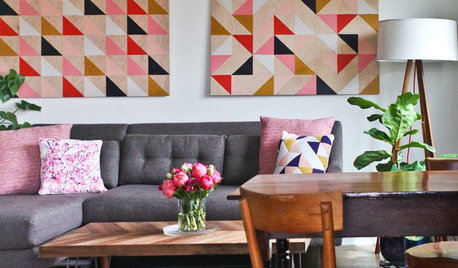

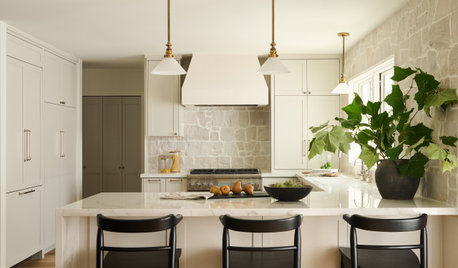
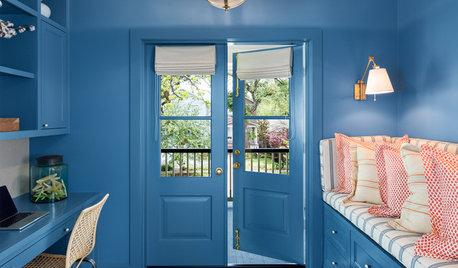

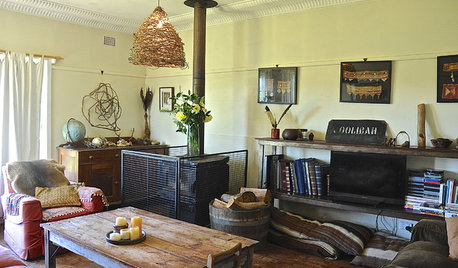
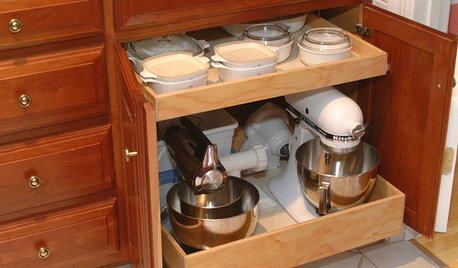







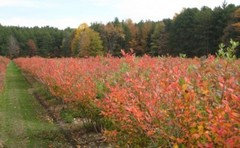
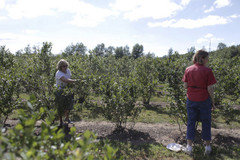

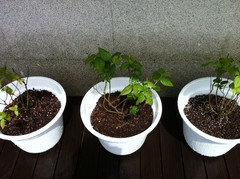

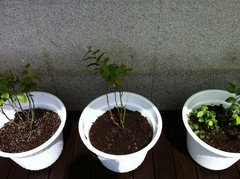
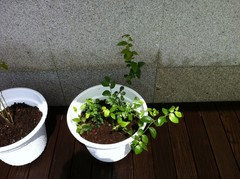
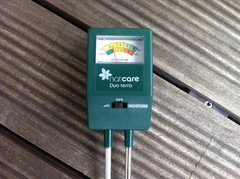


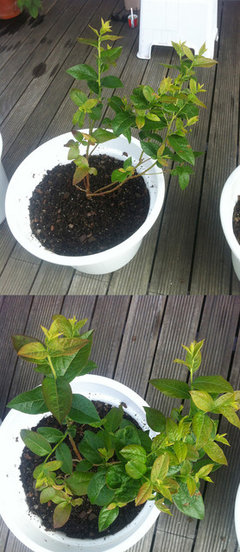



bamboo_rabbit